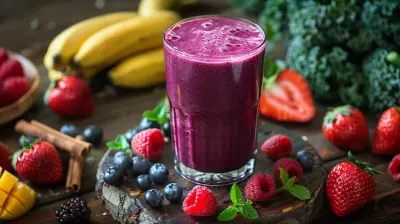The Connection Between Obesity and Diabetes
30 June 2025
Let’s be honest—talking about obesity and diabetes isn’t exactly cocktail party conversation. But hey, these two health issues are more connected than peanut butter and jelly (or should we say, like cake and frosting?). And understanding how they tie together just might be the golden ticket to taking better control of your health.
In this article, we’re going to break down the link between obesity and diabetes in a way that's easy to understand, a little fun (yes, really), and incredibly useful. So grab your favorite healthy drink, get comfy, and let’s dive into the science, the facts, and what you can actually do with this info.
What Exactly Is Obesity?
Alright, before we unpack the connection, we’ve got to understand what obesity is. Obesity isn’t just about a few extra pounds. It’s a medical condition where excess body fat has accumulated to the point that it might affect your health.Doctors typically use something called Body Mass Index (BMI) to measure obesity. A BMI of 30 or above? That’s considered obese. But the story doesn’t end there. BMI doesn’t account for muscle mass, bone density, or overall body composition, so it’s not perfect—but it gives us a starting point.
But here’s where things get tricky. Obesity doesn’t just change how you look. It changes how your body works. And that leads us to our next big player: diabetes.
So, What’s the Deal With Diabetes?
Now, diabetes is one of those health conditions a lot of us have heard about, maybe even know someone who lives with it. But do we really get it?There are a few types of diabetes, but the star of this show is Type 2 Diabetes. This type makes up around 90–95% of all diabetes cases. Essentially, it’s when your body becomes resistant to insulin (the hormone that regulates blood sugar), or it doesn’t make enough of it.
Think of insulin like a key that unlocks the doors to your cells so glucose (sugar) can enter and be used for energy. If the keys stop working or there aren’t enough of them, sugar builds up in your blood. That’s no bueno.
Obesity and Diabetes: The Not-So-Dynamic Duo
Here’s where things get juicy. Obesity and diabetes are best friends—but in the most toxic kind of way. In fact, obesity is one of the strongest risk factors for developing Type 2 diabetes. Some researchers even coined the term "diabesity" to reflect how closely these two conditions are tied together.Here’s how the domino effect works:
1. Fat Cells Are Busy (and Not in a Good Way)
Fat isn’t just sitting there like a couch potato. It’s active—especially the kind that gathers around your belly. This type of fat releases hormones and inflammatory chemicals that can mess with how your body uses insulin.2. Insulin Resistance Enters the Chat
As fat builds up, your cells don’t respond to insulin like they should. The result? Your pancreas has to pump more and more insulin just to keep up. Eventually, it can’t. That’s when blood sugar levels go haywire.3. Blood Sugar Rises, and Diabetes Follows
If this cycle keeps going unchecked, your body won’t be able to control blood sugar anymore—and boom, diabetes walks in and decides to stay a while.It’s not just theory. Studies show that over 80% of people with Type 2 diabetes are overweight or obese. That’s a pretty clear connection, don’t you think?
The Vicious Cycle: One Feeds the Other
OK, so obesity can lead to diabetes. But here’s the kicker—once diabetes sets in, it can actually make it harder to lose weight. Talk about a double whammy.Insulin resistance can encourage the body to store more fat rather than burn it. And some diabetes medications can lead to weight gain too. It becomes a never-ending loop unless we jump in and break the cycle.
Why Belly Fat Is Especially Bad News
Not all fat is created equal. The fat that clings around your abdomen—known as visceral fat—is particularly dangerous. Unlike the fat on your arms or thighs, visceral fat wraps around your internal organs and contributes mightily to insulin resistance.It’s kind of like a sneaky villain hiding in plain sight. You might not even be that heavy overall, but if you carry extra weight around your middle, you’re at a higher risk of diabetes.
The Role of Genetics—It’s Not Just About Willpower
Let’s pause for a second. It’s easy to blame obesity on bad habits, but it’s not always someone’s fault. Genetics play a big role in how your body stores fat, how hungry you feel, and how you process sugar.That said, while you can’t change your genes, you can change how you respond to them. Your environment, your habits, your mindset—all these things matter.
Can You Reverse the Damage?
Here’s the happy news: Absolutely YES.The connection between obesity and diabetes isn’t set in stone. With the right lifestyle changes, many people can prevent, manage, or even reverse Type 2 diabetes. Doesn’t that sound like a breath of fresh air?
Let’s talk about how.
7 Ways to Break the Obesity-Diabetes Link
1. Eat Real Food
Skip the ultra-processed stuff. Your body thrives on whole, nutrient-dense foods—think fruits, veggies, whole grains, leaning proteins, and healthy fats. Cutting back on sugar and refined carbs can work wonders for both weight and blood sugar.2. Move That Body
You don’t need to run a marathon (unless you want to!). Even brisk walking for 30 minutes a day can improve insulin sensitivity and help with weight loss.3. Get Your ZZZs
Lack of sleep can mess with your hunger hormones and insulin sensitivity. Aim for 7–9 hours a night.4. Manage Stress
Chronic stress increases cortisol, which can lead to weight gain—especially around the belly. Consider meditation, yoga, or even just deep breathing.5. Drink More Water
Staying hydrated helps your metabolism and can reduce cravings. Plus, it’s calorie-free!6. Watch Those Portions
You don’t need to go on a strict diet. Just becoming more mindful of how much you eat can help a lot.7. Regular Health Checks
Catching insulin resistance early is key. Talk to your doctor and get those numbers checked—especially if diabetes runs in your family.Mind Over Matter: The Power of Lifestyle Changes
It’s amazing what small changes can do. Studies show that losing just 5–7% of your body weight can significantly reduce your risk of developing diabetes. That’s like losing 10–15 pounds if you weigh 200 pounds. Totally doable, right?And no, it doesn’t mean giving up everything you love or living on kale forever. It’s about balance, consistency, and a sprinkle of self-love.
Busting the Myths
Let’s clear the air on a few things:- 🛑 Myth: "Only sugar causes diabetes."
✅ Truth: While sugar plays a role in blood sugar levels, it's more about overall diet, lifestyle, and body fat.
- 🛑 Myth: "Thin people don’t get diabetes."
✅ Truth: Even people with a normal weight can be insulin-resistant. It’s not just about the number on the scale.
- 🛑 Myth: "Once I have diabetes, there’s nothing I can do."
✅ Truth: You can manage and often reverse it with smart choices and medical guidance.
Real Stories, Real Hope
Ever heard of someone reversing their diabetes? It happens more than you think.Take Sarah (not her real name), a 45-year-old mom who was diagnosed with Type 2 diabetes. With the help of a nutritionist, she started walking 20 minutes a day, cut down on sugary drinks, and lost 20 pounds in 6 months. Her blood sugar levels? Back to normal. Her confidence? Through the roof.
You could be the next success story.
Final Thoughts
The connection between obesity and diabetes might be strong, but it’s not unbreakable. Think of your health like a garden. With the right tools, consistent care, and a little patience, it can flourish.So if you or someone you love is on this journey, know this: It’s not too late. Every healthy choice is a step in the right direction—and you’ve already taken one just by reading this article.
Stay joyful, stay hopeful, and remember: your body is cheering you on behind the scenes. Let’s give it a little love back, shall we?
all images in this post were generated using AI tools
Category:
DiabetesAuthor:

Madeline Howard
Discussion
rate this article
2 comments
Pia Larsen
Great article! Understanding the link between obesity and diabetes is crucial for promoting healthier lifestyles. Thank you for shedding light on this important topic and encouraging positive change for better health.
November 11, 2025 at 3:45 PM
Tamara McTigue
This article highlights the crucial link between obesity and diabetes, reminding us of the importance of healthy lifestyle choices.
July 11, 2025 at 4:29 AM

Madeline Howard
Thank you for your insightful comment! I'm glad you found the link between obesity and diabetes important—healthy lifestyle choices are indeed key to prevention.


